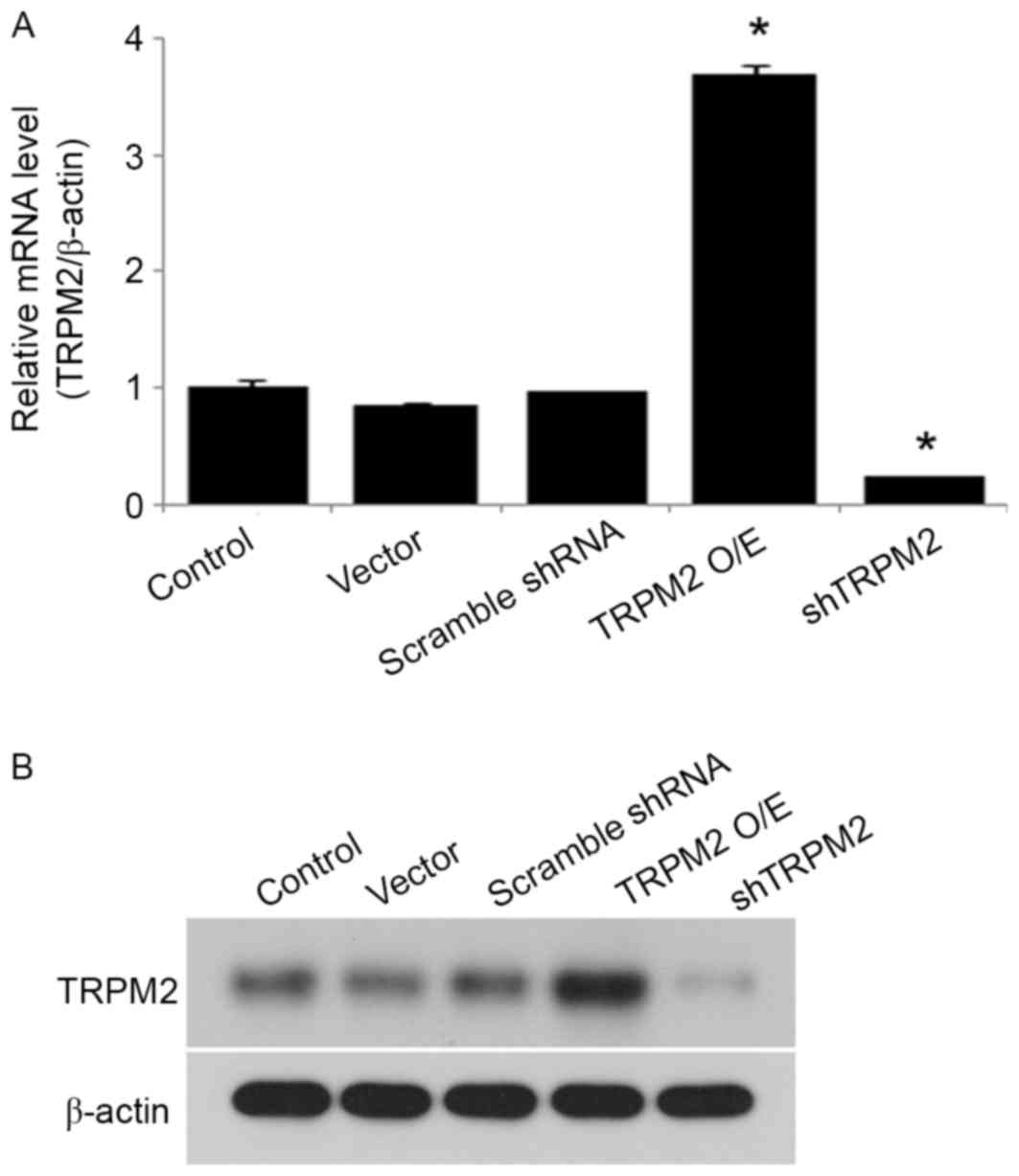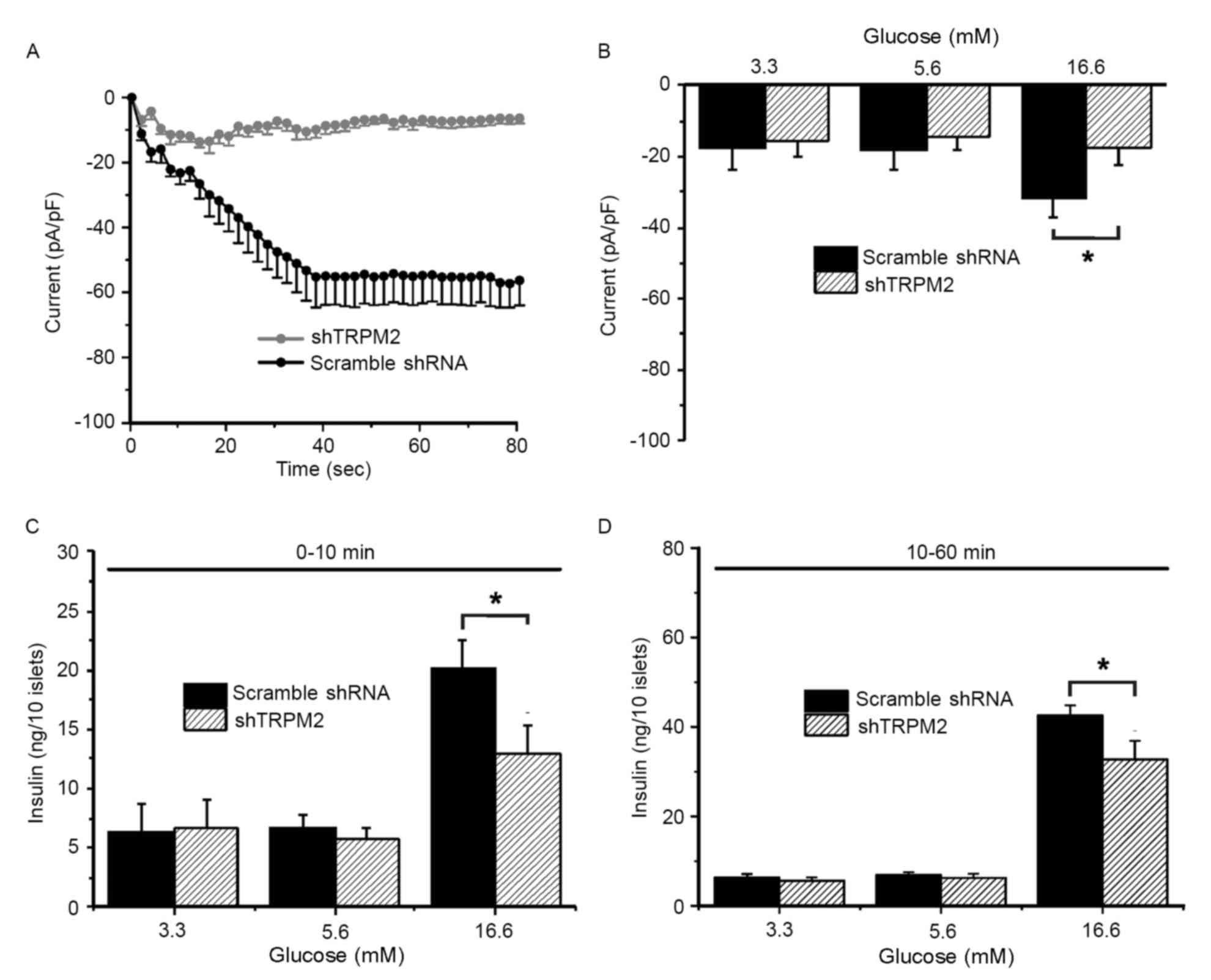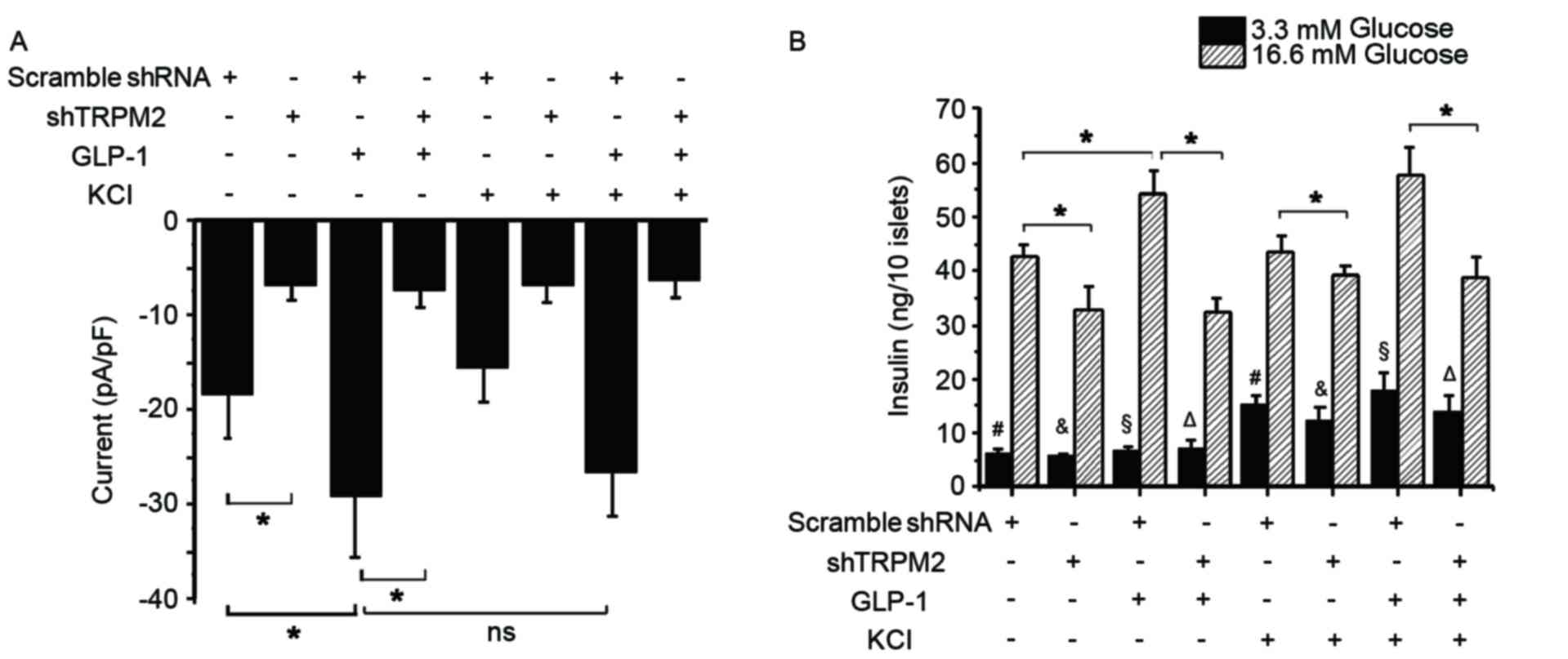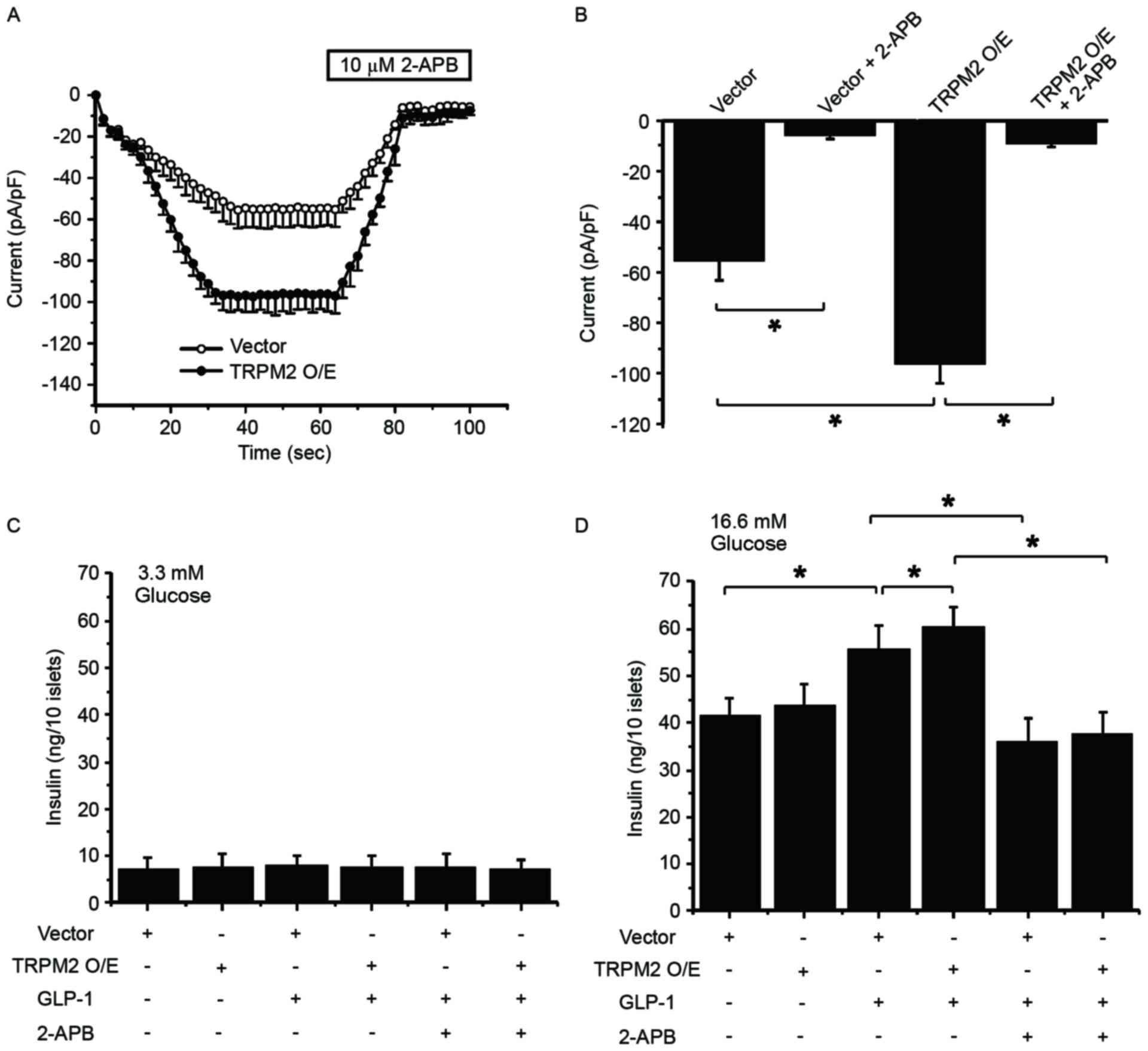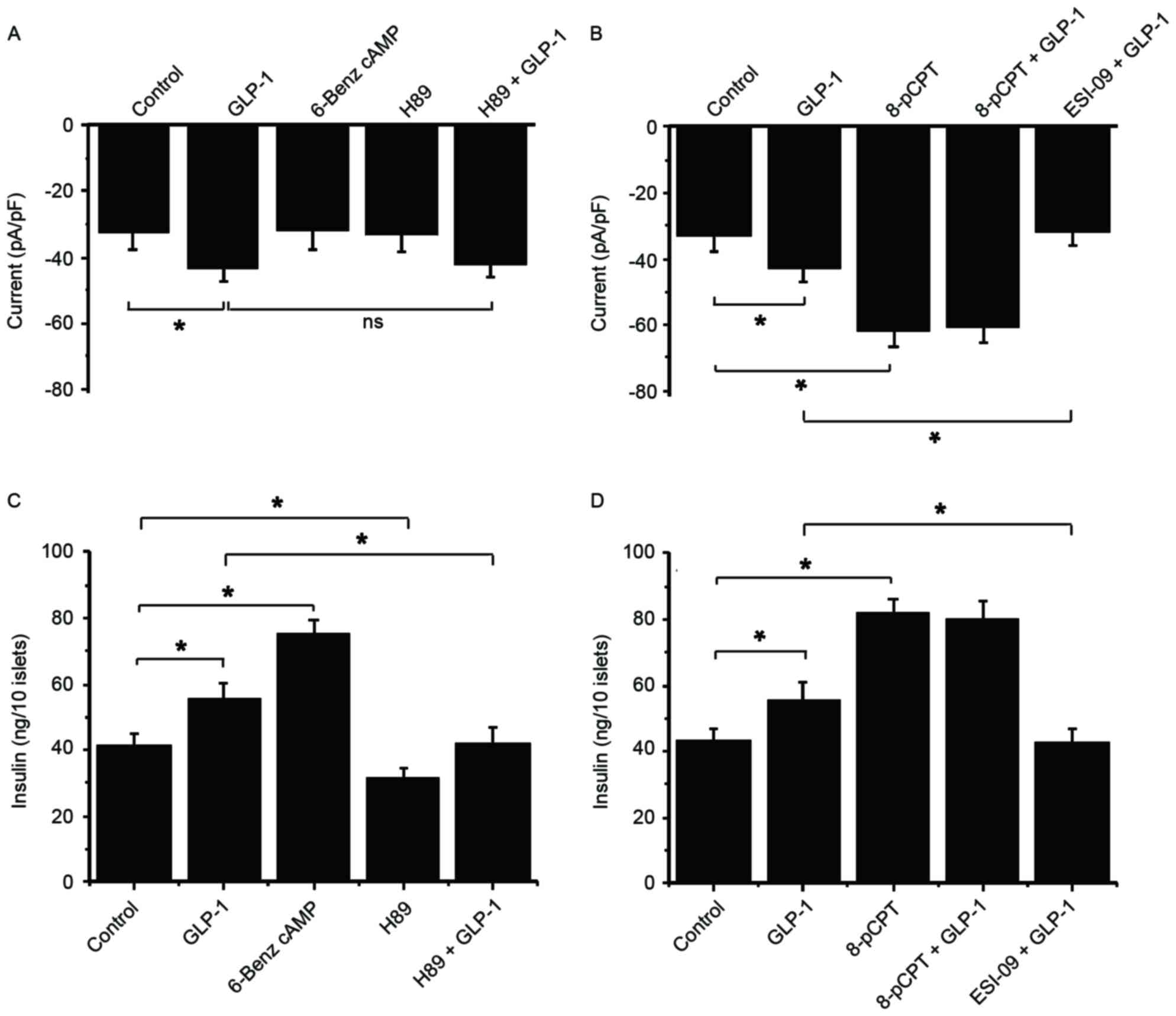|
1
|
Rorsman P, Eliasson L, Renström E, Gromada
J, Barg S and Göpel S: The cell physiology of biphasic insulin
secretion. News Pysiol Sci. 15:72–77. 2000.
|
|
2
|
Efanov AM, Zaitsev SV and Berggren PO:
Inositol hexakisphosphate stimulates non-Ca2+-mediated and primes
Ca2+-mediated exocytosis of insulin by activation of protein kinase
C. Proc Natl Acad Sci USA. 94:4435–4439. 1997. View Article : Google Scholar : PubMed/NCBI
|
|
3
|
Reinbothe TM, Alkayyali S, Ahlqvist E,
Tuomi T, Isomaa B, Lyssenko V and Renström E: The human L-type
calcium channel Cav1.3 regulates insulin release and polymorphisms
in CACNA1D associate with type 2 diabetes. Diabetologia.
56:340–349. 2013. View Article : Google Scholar : PubMed/NCBI
|
|
4
|
Dyachok O and Gylfe E: Store-operated
influx of Ca(2+) in pancreatic β-cells exhibits graded dependence
on the filling of the endoplasmic reticulum. J Cell Sci.
114:2179–2186. 2001.PubMed/NCBI
|
|
5
|
Owsianik G, Talavera K, Voets T and Nilius
B: Permeation and selectivity of TRP channels. Annu Rev Physiol.
68:685–717. 2006. View Article : Google Scholar : PubMed/NCBI
|
|
6
|
Colsoul B, Vennekens R and Nilius B:
Transient receptor potential cation channels pancreatic-β cells.
Rev Physiol Biochem Pharmacol. 161:87–110. 2011.PubMed/NCBI
|
|
7
|
Zhang Z, Zhang W, Jung DY, Ko HJ, Lee Y,
Friedline RH, Lee E, Jun J, Ma Z, Kim F, et al: TRPM2 Ca2+ channel
regulates energy balance and glucose metabolism. Am J Physiol
Endocrinol Metab. 302:E807–E816. 2012. View Article : Google Scholar : PubMed/NCBI
|
|
8
|
Kim W and Egan JM: The role of incretins
in glucose homeostasis and diabetes treatment. Pharmacol Rev.
60:470–512. 2008. View Article : Google Scholar : PubMed/NCBI
|
|
9
|
Wang XL, Ye F, Li J, Zhu LY, Feng G, Chang
XY and Sun K: Impaired secretion of glucagon-like peptide 1 during
oral glucose tolerance test in patients with newly diagnosed type 2
diabetes mellitus. Saudi Med J. 37:48–54. 2016. View Article : Google Scholar : PubMed/NCBI
|
|
10
|
Freeman JS: Improving glucagon-like
peptide-1 dynamics in patients with type 2 diabetes mellitus. J Am
Osteopath Assoc. 112 1 Suppl 1:S2–S6. 2012.PubMed/NCBI
|
|
11
|
Gavin JR III: Initiating a glucagon-like
peptide-1 receptor agonist in the management of type 2 diabetes
mellitus. J Am Osteopath Assoc. 112 1 Suppl 1:S16–S21.
2012.PubMed/NCBI
|
|
12
|
Meloni AR, DeYoung MB, Lowe C and Parkes
DG: GLP-1 receptor activated insulin secretion from pancreatic
β-cells: Mechanism and glucose dependence. Diabetes Obes Metab.
15:15–27. 2013. View Article : Google Scholar : PubMed/NCBI
|
|
13
|
Bahlouli S, Mokaddem A, Hamdache F, Riane
H and Kamenche M: Fractal behavior of the pancreatic β-cell near
the percolation threshold: Effect of the KATP channel on the
electrical response. IEEE/ACM Trans Comput Biol Bioinform.
13:112–121. 2016. View Article : Google Scholar : PubMed/NCBI
|
|
14
|
Toft-Nielsen MB, Madsbad S and Holst JJ:
Determinants of the effectiveness of glucagon-like peptide-1 in
type 2 diabetes. J Clin Endocrinol Metab. 86:3853–3860. 2001.
View Article : Google Scholar : PubMed/NCBI
|
|
15
|
Oetjen E, Diedrich T, Eggers A, Eckert B
and Knepel W: Distinct properties of the cAMP-responsive element of
the rat insulin I gene. J Biol Chem. 269:27036–27044.
1994.PubMed/NCBI
|
|
16
|
Henquin JC: Triggering and amplifying
pathways of regulation of insulin secretion by glucose. Diabetes.
49:1751–1760. 2000. View Article : Google Scholar : PubMed/NCBI
|
|
17
|
Fonfria E, Marshall IC, Benham CD,
Boyfield I, Brown JD, Hill K, Hughes JP, Skaper SD and McNulty S:
TRPM2 channel opening in response to oxidative stress is dependent
on activation of poly(ADP-ribose) polymerase. Br J Pharmacol.
143:186–192. 2004. View Article : Google Scholar : PubMed/NCBI
|
|
18
|
Yamamoto S, Shimizu S, Kiyonaka S,
Takahashi N, Wajima T, Hara Y, Negoro T, Hiroi T, Kiuchi Y, Okada
T, et al: TRPM2-mediated Ca2+ influx induces chemokine production
in monocytes that aggravates inflammatory neutrophil infiltration.
Nat Med. 14:738–747. 2008. View
Article : Google Scholar : PubMed/NCBI
|
|
19
|
Hong CW, Kim TK, Ham HY, Nam JS, Kim YH,
Zheng H, Pang B, Min TK, Jung JS, Lee SN, et al:
Lysophosphatidylcholine increases neutrophil bactericidal activity
by enhancement of azurophil granule-phagosome fusion via glycine.
GlyR alpha 2/TRPM2/p38 MAPK signaling. J Immunol. 184:4401–4413.
2010. View Article : Google Scholar : PubMed/NCBI
|
|
20
|
Wehrhahn J, Kraft R, Harteneck C and
Hauschildt S: Transient receptor potential melastatin 2 is required
for lipopolysaccharide-induced cytokine production in human
monocytes. J Immunol. 184:2386–2393. 2010. View Article : Google Scholar : PubMed/NCBI
|
|
21
|
Togashi K, Hara Y, Tominaga T, Higashi T,
Konishi Y, Mori Y and Tominaga M: TRPM2 activation by cyclic
ADP-ribose at body temperature is involved in insulin secretion.
EMBO J. 25:1804–1815. 2006. View Article : Google Scholar : PubMed/NCBI
|
|
22
|
Perraud AL, Fleig A, Dunn CA, Bagley LA,
Launay P, Schmitz C, Stokes AJ, Zhu Q, Bessman MJ, Penner R, et al:
ADP-ribose gating of the calcium-permeable LTRPC2 channel revealed
by Nudix motif homology. Nature. 411:595–599. 2001. View Article : Google Scholar : PubMed/NCBI
|
|
23
|
Beck A, Kolisek M, Bagley LA, Fleig A and
Penner R: Nicotinic acid adenine dinucleotide phosphate and cyclic
ADP-ribose regulate TRPM2 channels in T lymphocytes. FASEB J.
20:962–964. 2006. View Article : Google Scholar : PubMed/NCBI
|
|
24
|
Starkus JG, Fleig A and Penner R: The
Calcium-permeable non-selective cation channel TRPM2 is modulated
by cellular acidification. J Physiol. 588:1227–1240. 2010.
View Article : Google Scholar : PubMed/NCBI
|
|
25
|
Kühn FJ, Heiner I and Lückhoff A: TRPM2: A
calcium influx pathway regulated by oxidative stress and the novel
second messenger ADP-ribose. Pflugers Arch. 451:212–219. 2005.
View Article : Google Scholar : PubMed/NCBI
|
|
26
|
Naziroğlu M: New molecular mechanisms on
the activation of TRPM2 channels by oxidative stress and
ADP-ribose. Neurochem Res. 32:1990–2001. 2007. View Article : Google Scholar : PubMed/NCBI
|
|
27
|
Pang B, Shin DH, Park KS, Huh YJ, Woo J,
Zhang YH, Kang TM, Lee KY and Kim SJ: Differential pathways for
calcium influx activated by concanavalin A and CD3 stimulation in
Jurkat T cells. Pflugers Arch. 463:309–318. 2012. View Article : Google Scholar : PubMed/NCBI
|
|
28
|
Uchida K, Dezaki K, Damdindor B, Inada H,
Shiuchi T, Mori Y, Yada T, Minokoshi Y and Tominaga M: Lack of
TRPM2 impaired insulin secretion and glucose metabolisms in mice.
Diabetes. 60:119–126. 2011. View Article : Google Scholar : PubMed/NCBI
|
|
29
|
Egan JM, Bulotta A, Hui H and Perfetti R:
GLP-1 receptor agonists are growth and differentiation factors for
pancreatic islet beta cells. Diabetes Metab Res Rev. 19:115–123.
2003. View Article : Google Scholar : PubMed/NCBI
|
|
30
|
Yusta B, Baggio LL, Estall JL, Koehler JA,
Holland DP, Li H, Pipeleers D, Ling Z and Drucker DJ: GLP-1
receptor activation improves beta cell function and survival
following induction of endoplasmic reticulum stress. Cell Metab.
4:391–406. 2006. View Article : Google Scholar : PubMed/NCBI
|
|
31
|
Gomez E, Pritchard C and Herbert TP:
cAMP-dependent protein kinase and Ca2+ influx through L-type
voltage-gated calcium channels mediate Raf-independent activation
of extracellular regulated kinase in response to glucogon-like
peptide-1 in pancreatic beta-cells. J Biol Chem. 277:48146–48151.
2002. View Article : Google Scholar : PubMed/NCBI
|
|
32
|
Arnette D, Gibson TB, Lawrence MC, January
B, Khoo S, McGlynn K, Vanderbilt CA and Cobb MH: Regulation of ERK1
and ERK2 by glucose and peptide hormones in pancreatic beta cells.
J Biol Chem. 278:32517–32525. 2003. View Article : Google Scholar : PubMed/NCBI
|
|
33
|
Buteau J, Roduit R, Susini S and Prentki
M: Glucagon-like peptide-1 promotes DNA synthesis, activates
phosphatidylinositol 3-kinase and increase transcription factor
pancreatic and duodenal homeobox gene 1 (PDX-1) DNA binding
activity in beta (INS-1)-cells. Diabetologia. 42:856–864. 1999.
View Article : Google Scholar : PubMed/NCBI
|
|
34
|
Ozaki N, Shibasaki T, Kashima Y, Miki T,
Takahashi K, Ueno H, Sunaga Y, Yano H, Matsuura Y, Iwanaga T, et
al: cAMP-GEFII is a direct target of cAMP in regulated exocytosis.
Nat Cell Biol. 2:805–811. 2000. View Article : Google Scholar : PubMed/NCBI
|
|
35
|
Renstrom E, Eliasson L and Rorsman P:
Protein kinase A-dependent and -independent stimulation of
exocytosis by cAMP in mouse pancreatic β-cells. J Physiol.
502:105–118. 1997. View Article : Google Scholar : PubMed/NCBI
|
|
36
|
Kang G, Joseph JW, Chepurny OG, Monaco M,
Wheeler MB, Bos JL, Schwede F, Genieser HG and Holz GG:
Epac-selective cAMP analog 8-pCPT-2′-O-Me-cAMP as a stimulus for
Ca2+-induced Ca2+ release and exocytosis in pancreatic beta-cells.
J Biol Chem. 278:8279–8285. 2003. View Article : Google Scholar : PubMed/NCBI
|
|
37
|
Fujimoto K, Shibasaki T, Yokoi N, Nashima
Y, Matsumoto M, Sasaki T, Tajima N, Iwanaga T and Seino S: Piccolo,
a Ca2+ sensor in pancreatic beta-cells. Involvement of cAMP-GEFII.
Rim2. Piccolo complex in cAMP-dependent exocytosis. J Biol Chem.
277:50497–50502. 2002. View Article : Google Scholar : PubMed/NCBI
|
|
38
|
Kashima Y, Miki T, Shibasaki T, Ozaki N,
Miyazaki M, Yano H and Seino S: Critical role of cAMP-GEFFII-Rim2
complex in incretin-protentiated insulin secretion. J Biol Chem.
276:46046–46053. 2001. View Article : Google Scholar : PubMed/NCBI
|
|
39
|
Overbergh L, Vig S, Coun F and Mathieu C:
Chapter 4: Quantitative polymerase chain reactionMolecular
Diagnostics. 3rd. Patrinos GP: Academic Press; pp. 41–58. 2017,
View Article : Google Scholar
|
|
40
|
Damdindorj B, Dezaki K, Kurashina T, Sone
H, Rita R, Kakei M and Yada T: Exogenous and endogenous ghrelin
counteracts GLP-1 action to stimulate cAMP signaling and insulin
secretion in islet β-cells. FEBS Lett. 586:2555–2562. 2012.
View Article : Google Scholar : PubMed/NCBI
|
|
41
|
Holz GG, Heart E and Leech CA:
Synchronizing Ca2+ and cAMP oscillations in pancreatic beta-cells:
A role for glucose metabolism and GLP-1 receptors? Focus on
‘regulation of cAMP dynamics by Ca2+ and G protein-coupled
receptors in the pancreatic beta-cell: A computational approach’.
Am J Physiol Cell Physiol. 294:C4–C6. 2008. View Article : Google Scholar : PubMed/NCBI
|
|
42
|
Shigeto M, Katsura M, Matsuda M, Ohkuma S
and Kaku K: Low, but physiological, concentration of GLP-1
stimulates insulin secretion independent of the cAMP-dependent
protein kinase pathway. J Pharmacol Sci. 108:274–279. 2008.
View Article : Google Scholar : PubMed/NCBI
|
|
43
|
Doyle ME and Egan JM: Mechanisms of action
of glucagon-like peptide 1 in the pancreas. Pharmacol Ther.
113:546–593. 2007. View Article : Google Scholar : PubMed/NCBI
|
|
44
|
Takasawa S, Nata K, Yonekura H and Okamoto
H: Cyclic ADP-ribose in insulin secretion from pancreatic beta
cells. Science. 259:370–373. 1993. View Article : Google Scholar : PubMed/NCBI
|
|
45
|
Kim BJ, Park KH, Yim CY, Takasawa S,
Okamoto H, Im MJ and Kim UH: Generation of nicotinic acid adenine
dinucleotide phosphate and cyclic ADP-ribose by glucagon-like
peptide-1 evokes Ca2+ signal that is essential for insulin
secretion in mouse pancreatic islets. Diabetes. 57:868–878. 2008.
View Article : Google Scholar : PubMed/NCBI
|
|
46
|
Fridlyand LE and Philipson LH: Coupling of
metabolic, second messenger pathways and insulin granule dynamics
in pancreatic beta-cells: A computational analysis. Prog Biophys
Mol Biol. 107:293–303. 2011. View Article : Google Scholar : PubMed/NCBI
|
|
47
|
Park S, Dong X, Fisher TL, Dunn S, Omer
AK, Weir G and White MF: Exendin-4 uses Irs2 signaling to mediate
pancreatic beta cell growth and function. J Biol Chem.
281:1159–1168. 2006. View Article : Google Scholar : PubMed/NCBI
|















